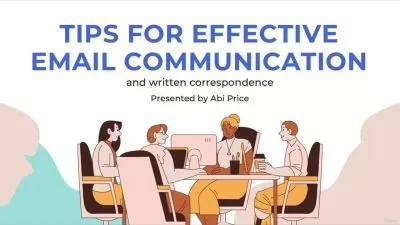Learn Cross-Cultural Communication: 100 Lessons Masterclass
Peter Alkema,Irlon Terblanche
8:53:49
Description
Bridging Cultures For Personal Growth and Business Success: Mastering Cross Cultural Communication in a Diverse World
What You'll Learn?
- Recall the definition of cross-cultural communication and its significance in a globalized world.
- Explain the concept of cultural dimensions using Hofstede's Model and its impact on communication styles.
- Utilize active listening skills to interpret non-verbal cues in a cross-cultural interaction.
- Differentiate between high-context and low-context communication styles and their use in specific cultural settings.
- Assess your own cultural biases and their influence on communication effectiveness.
- Develop a personal action plan to enhance your cross-cultural communication skills based on self-assessment results.
- Implement techniques to build rapport across different cultures in a simulated networking event.
- Examine a case study on workplace dynamics to identify cultural misunderstandings and propose solutions.
- Critically review a cross-cultural negotiation scenario to identify strategies that led to its success or failure.
- Design a culturally sensitive marketing plan for a product launch in a new international market.
- Conduct a role-play exercise to navigate a conversation using direct and indirect communication styles appropriate to the cultural context.
- Describe the impact of cultural stereotypes on communication and relationships in a diverse team setting.
- Compare and contrast the effectiveness of different cross-cultural team building techniques in improving team collaboration.
- Judge the appropriateness of different leadership styles in managing a culturally diverse team and motivating team members.
- Formulate strategies for overcoming language barriers in a multicultural business meeting.
- Execute a simulated negotiation exercise demonstrating awareness of cultural considerations in negotiation styles.
- Summarize the challenges and advantages of virtual communication across different cultures.
- Dissect an international marketing campaign to identify elements of cultural sensitivity and potential areas of cultural offense.
- Critique your approach to resolving a cross-cultural conflict, incorporating feedback from peers and instructors.
- Propose an initiative to promote ethics and corporate responsibility in a global organization, considering cultural norms and values.
- Facilitate a discussion in a virtual team setting, employing netiquette principles across cultures to enhance collaboration.
- Interpret the components of cultural intelligence (CQ) and their relevance to personal and professional development.
- Assess the return on investment (ROI) of cross-cultural training initiatives within an organization through case study analysis.
- Reflect on personal experiences of cultural shock and develop strategies for managing and overcoming these challenges.
- Innovate a cross-cultural communication strategy for a multinational team project, ensuring inclusivity and effectiveness.
- Use ethical decision-making models in diverse scenarios to navigate cultural dilemmas in a global business context.
- Outline the principles of international business etiquette and their importance in global interactions.
- Identify patterns of cultural adaptation and adjustment in expatriates, drawing on shared experiences in discussion forums.
- Critically examine the impact of cultural diversity on team success, using specific examples from case studies.
- Develop a continuous cultural learning and development plan for an organization, incorporating feedback mechanisms for improvement.
Who is this for?
What You Need to Know?
More details
DescriptionThis is a comprehensive course designed to equip learners with the essential skills and knowledge needed to navigate the complexities of communicating across diverse cultural backgrounds. This course is structured to address the challenges of global interactions, offering practical strategies for enhancing communication and understanding in a multicultural environment. Here's a breakdown of each section and what learners can expect:
1. Introduction to Cross-Cultural Communication
Defining Cross-Cultural Communication: Introduction to the basic concepts, importance in today's globalized world, and common challenges and misconceptions.
Overview of Course Structure and Objectives: Lays out the course's roadmap and what learners will achieve.
Interactive Activity: A self-assessment to gauge learners' current cross-cultural skills.
2. Understanding Culture
Defining Culture: Explores the concept of culture beyond just traditions, including national, regional, and organizational layers.
Cultural Dimensions and Frameworks: Introduction to Hofstede's model and other frameworks to understand cultural differences.
Understanding Your Own Cultural Biases: Guides learners through recognizing and addressing their own biases.
3. Communication Styles Across Cultures
High-Context vs. Low-Context Communication: Differences between cultures that rely on implicit vs. explicit communication.
Direct vs. Indirect Communication: Understanding how directness in communication varies across cultures.
Understanding Non-Verbal Cues: How to read and use non-verbal communication effectively in different cultural contexts.
4. Building Skills for Cross-Cultural Communication
Active Listening Skills: Techniques for effective listening in a cross-cultural setting.
Empathy: Developing the ability to understand and share the feelings of another from different cultural backgrounds.
Techniques to Build Rapport: Strategies for creating connections across cultures.
5. Overcoming Communication Barriers
Overcoming Language Barriers: Strategies for effective communication despite language differences.
Cultural Adaptation and Flexibility: How to adapt your communication style and behavior in different cultural contexts.
Identifying and Challenging Cultural Stereotypes: Recognizing stereotypes and their impact on communication.
6. Cross-Cultural Negotiation and Leadership
Fundamentals of Cross-Cultural Negotiation: Understanding cultural considerations in negotiation styles.
Qualities of an Effective Cross-Cultural Leader: Managing and motivating culturally diverse teams.
7. Virtual Communication Across Cultures
Challenges of Cross-Cultural Virtual Communication: Navigating the nuances of digital communication with team members from around the globe.
Building Virtual Teams Across Cultures: Strategies for fostering collaboration and team spirit in a virtual setting.
8. Global Marketing and Team Building
Global Marketing: Adapting marketing strategies to cater to cultural sensitivities and preferences.
Principles of Cross-Cultural Team Building: Leveraging cultural diversity for team success and overcoming cultural barriers in team dynamics.
9. Preparing for International Assignments
Cultural Shock: Strategies for managing and overcoming cultural shock.
Developing Support Systems: Essential for success in international assignments, including adjustment strategies for expatriates and their families.
10. Ethics and Compliance in a Global Context
Understanding Cultural Differences in Ethics: Navigating ethical dilemmas in international business.
International Compliance and Regulations: Ensuring ethical conduct and understanding global compliance standards.
11. Developing a Global Mindset
Components of Cultural Intelligence (CQ): Enhancing personal cultural intelligence for global business success.
Effective Strategies for Language Challenges: Tips for using interpreters, translation services, and improving language skills for professional development.
12. Business Etiquette Around the World
Global Dining Etiquette: Understanding cultural norms in meetings, negotiations, and professional dress codes.
Networking and Relationship Building: Strategies for successful networking and building professional relationships across cultures.
13. Managing Cultural Conflict
Understanding the Roots of Cultural Conflict: Techniques for resolving cross-cultural disputes and mediation strategies.
Developing a Personal Action Plan: For applying cross-cultural communication strategies in professional and personal settings.
14. Continuous Learning and Development
Tools and Techniques for Evaluating Training Effectiveness: Methods for collecting feedback and ensuring continuous improvement in cross-cultural competence.
15. Ethical Considerations in Cross-Cultural Interactions
Respecting Cultural Norms and Values: Explores the importance of ethical behavior and respect for cultural diversity in global interactions.
Corporate Responsibility in a Global Context: Discusses how businesses can uphold ethical standards and corporate responsibility across different cultures.
Case Study: Ethical Dilemma in a Multicultural Setting: Provides real-world scenarios to analyze ethical challenges and decision-making in a cross-cultural context.
Panel Discussion: Ethics in International Business: Features insights from industry experts on navigating ethical considerations in global business practices.
16. Key Takeaways and Action Planning
Developing a Personal Action Plan for Cross-Cultural Communication: Guides learners through creating a personalized strategy to apply the skills and knowledge gained from the course in their professional and personal lives.
Resources for Continuous Learning: Offers a curated list of resources, including books, articles, and websites, for learners to continue their journey in cross-cultural understanding beyond the course.
Feedback Session and Course Evaluation: Provides an opportunity for learners to give feedback on the course, share their learning experience, and discuss improvements for future iterations.
17. Final Project: Cross-Cultural Communication Strategy Proposal
Assignment Overview: Learners are tasked with developing a comprehensive cross-cultural communication strategy for a hypothetical or real-life project within their organization or community. This capstone project allows participants to apply the concepts, frameworks, and strategies learned throughout the course to a practical scenario.
Presentation and Peer Review: Learners present their proposals to their peers for review and constructive feedback, fostering a collaborative learning environment and allowing for diverse perspectives.
Evaluation and Reflection: The final project is evaluated based on its practicality, creativity, and alignment with best practices in cross-cultural communication. Learners are encouraged to reflect on their growth throughout the course and identify areas for continued improvement.
Upon completion of "The Fundamentals of Cross-Cultural Communication," participants will have a solid foundation in cross-cultural communication principles, enhanced cultural intelligence, and practical skills for effectively interacting with people from diverse backgrounds. This course is ideal for professionals working in international contexts, individuals preparing for global assignments, and anyone interested in improving their cross-cultural communication skills for personal or professional development. Join us to bridge cultural gaps, foster mutual understanding, and thrive in a globalized world.
Who this course is for:
- Individuals working in multinational corporations or those who are preparing for international assignments. They are driven by the need to navigate business negotiations, teamwork, and leadership across cultural boundaries effectively.
- Professionals responsible for implementing diversity and inclusion initiatives, developing multicultural teams, and managing cross-cultural training programs within their organizations.
- Those involved in creating and executing marketing strategies and sales plans that must resonate with diverse international markets. They seek to understand cultural nuances that affect consumer behavior and communication strategies.
- Individuals planning to live, work, or study abroad who need to adapt to a new cultural environment, minimize culture shock, and build meaningful relationships with people from different cultural backgrounds.
- Teachers, professors, and administrators in international or multicultural education settings looking to foster inclusive classrooms, improve communication with students from diverse backgrounds, and prepare students for global citizenship.
- People working in international development, humanitarian aid, and intercultural exchange programs who require effective cross-cultural communication skills to collaborate with local communities and international teams.
This is a comprehensive course designed to equip learners with the essential skills and knowledge needed to navigate the complexities of communicating across diverse cultural backgrounds. This course is structured to address the challenges of global interactions, offering practical strategies for enhancing communication and understanding in a multicultural environment. Here's a breakdown of each section and what learners can expect:
1. Introduction to Cross-Cultural Communication
Defining Cross-Cultural Communication: Introduction to the basic concepts, importance in today's globalized world, and common challenges and misconceptions.
Overview of Course Structure and Objectives: Lays out the course's roadmap and what learners will achieve.
Interactive Activity: A self-assessment to gauge learners' current cross-cultural skills.
2. Understanding Culture
Defining Culture: Explores the concept of culture beyond just traditions, including national, regional, and organizational layers.
Cultural Dimensions and Frameworks: Introduction to Hofstede's model and other frameworks to understand cultural differences.
Understanding Your Own Cultural Biases: Guides learners through recognizing and addressing their own biases.
3. Communication Styles Across Cultures
High-Context vs. Low-Context Communication: Differences between cultures that rely on implicit vs. explicit communication.
Direct vs. Indirect Communication: Understanding how directness in communication varies across cultures.
Understanding Non-Verbal Cues: How to read and use non-verbal communication effectively in different cultural contexts.
4. Building Skills for Cross-Cultural Communication
Active Listening Skills: Techniques for effective listening in a cross-cultural setting.
Empathy: Developing the ability to understand and share the feelings of another from different cultural backgrounds.
Techniques to Build Rapport: Strategies for creating connections across cultures.
5. Overcoming Communication Barriers
Overcoming Language Barriers: Strategies for effective communication despite language differences.
Cultural Adaptation and Flexibility: How to adapt your communication style and behavior in different cultural contexts.
Identifying and Challenging Cultural Stereotypes: Recognizing stereotypes and their impact on communication.
6. Cross-Cultural Negotiation and Leadership
Fundamentals of Cross-Cultural Negotiation: Understanding cultural considerations in negotiation styles.
Qualities of an Effective Cross-Cultural Leader: Managing and motivating culturally diverse teams.
7. Virtual Communication Across Cultures
Challenges of Cross-Cultural Virtual Communication: Navigating the nuances of digital communication with team members from around the globe.
Building Virtual Teams Across Cultures: Strategies for fostering collaboration and team spirit in a virtual setting.
8. Global Marketing and Team Building
Global Marketing: Adapting marketing strategies to cater to cultural sensitivities and preferences.
Principles of Cross-Cultural Team Building: Leveraging cultural diversity for team success and overcoming cultural barriers in team dynamics.
9. Preparing for International Assignments
Cultural Shock: Strategies for managing and overcoming cultural shock.
Developing Support Systems: Essential for success in international assignments, including adjustment strategies for expatriates and their families.
10. Ethics and Compliance in a Global Context
Understanding Cultural Differences in Ethics: Navigating ethical dilemmas in international business.
International Compliance and Regulations: Ensuring ethical conduct and understanding global compliance standards.
11. Developing a Global Mindset
Components of Cultural Intelligence (CQ): Enhancing personal cultural intelligence for global business success.
Effective Strategies for Language Challenges: Tips for using interpreters, translation services, and improving language skills for professional development.
12. Business Etiquette Around the World
Global Dining Etiquette: Understanding cultural norms in meetings, negotiations, and professional dress codes.
Networking and Relationship Building: Strategies for successful networking and building professional relationships across cultures.
13. Managing Cultural Conflict
Understanding the Roots of Cultural Conflict: Techniques for resolving cross-cultural disputes and mediation strategies.
Developing a Personal Action Plan: For applying cross-cultural communication strategies in professional and personal settings.
14. Continuous Learning and Development
Tools and Techniques for Evaluating Training Effectiveness: Methods for collecting feedback and ensuring continuous improvement in cross-cultural competence.
15. Ethical Considerations in Cross-Cultural Interactions
Respecting Cultural Norms and Values: Explores the importance of ethical behavior and respect for cultural diversity in global interactions.
Corporate Responsibility in a Global Context: Discusses how businesses can uphold ethical standards and corporate responsibility across different cultures.
Case Study: Ethical Dilemma in a Multicultural Setting: Provides real-world scenarios to analyze ethical challenges and decision-making in a cross-cultural context.
Panel Discussion: Ethics in International Business: Features insights from industry experts on navigating ethical considerations in global business practices.
16. Key Takeaways and Action Planning
Developing a Personal Action Plan for Cross-Cultural Communication: Guides learners through creating a personalized strategy to apply the skills and knowledge gained from the course in their professional and personal lives.
Resources for Continuous Learning: Offers a curated list of resources, including books, articles, and websites, for learners to continue their journey in cross-cultural understanding beyond the course.
Feedback Session and Course Evaluation: Provides an opportunity for learners to give feedback on the course, share their learning experience, and discuss improvements for future iterations.
17. Final Project: Cross-Cultural Communication Strategy Proposal
Assignment Overview: Learners are tasked with developing a comprehensive cross-cultural communication strategy for a hypothetical or real-life project within their organization or community. This capstone project allows participants to apply the concepts, frameworks, and strategies learned throughout the course to a practical scenario.
Presentation and Peer Review: Learners present their proposals to their peers for review and constructive feedback, fostering a collaborative learning environment and allowing for diverse perspectives.
Evaluation and Reflection: The final project is evaluated based on its practicality, creativity, and alignment with best practices in cross-cultural communication. Learners are encouraged to reflect on their growth throughout the course and identify areas for continued improvement.
Upon completion of "The Fundamentals of Cross-Cultural Communication," participants will have a solid foundation in cross-cultural communication principles, enhanced cultural intelligence, and practical skills for effectively interacting with people from diverse backgrounds. This course is ideal for professionals working in international contexts, individuals preparing for global assignments, and anyone interested in improving their cross-cultural communication skills for personal or professional development. Join us to bridge cultural gaps, foster mutual understanding, and thrive in a globalized world.
Who this course is for:
- Individuals working in multinational corporations or those who are preparing for international assignments. They are driven by the need to navigate business negotiations, teamwork, and leadership across cultural boundaries effectively.
- Professionals responsible for implementing diversity and inclusion initiatives, developing multicultural teams, and managing cross-cultural training programs within their organizations.
- Those involved in creating and executing marketing strategies and sales plans that must resonate with diverse international markets. They seek to understand cultural nuances that affect consumer behavior and communication strategies.
- Individuals planning to live, work, or study abroad who need to adapt to a new cultural environment, minimize culture shock, and build meaningful relationships with people from different cultural backgrounds.
- Teachers, professors, and administrators in international or multicultural education settings looking to foster inclusive classrooms, improve communication with students from diverse backgrounds, and prepare students for global citizenship.
- People working in international development, humanitarian aid, and intercultural exchange programs who require effective cross-cultural communication skills to collaborate with local communities and international teams.
User Reviews
Rating
Peter Alkema
Instructor's CoursesIrlon Terblanche
Instructor's Courses
Udemy
View courses Udemy- language english
- Training sessions 105
- duration 8:53:49
- Release Date 2024/05/18










